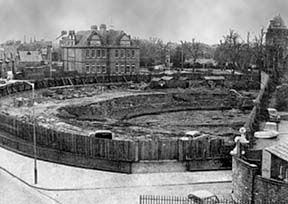Heritage and that old Chestnut
Digging holes and interpreting what we find within forms a part
of the role of an archaeologist. This is what we've been telling the numerous
people who've stopped by to inspect our rather wonderful excavation. But why do
it in such a very public place? Clearly the very obvious response is, because
that’s where the archaeology is. However, we could just as easily clear off to
a hillfort in Wales, excavating, recording and interpreting as we go; and we
do.
Whilst the latter ticks all the boxes in terms of
archaeological research it also lowers accessibility to the public generally
and we run the risk of inadvertently returning archaeology to a realm of
exclusivity typified by Chester’s amphitheatre excavations during the 1960’s.
You’ll notice from the photograph that the impenetrable wall surrounding the
site pretty much rules out any prospect of public participation; it also kept
the archaeologists out of pubs, which is possibly a good thing.
I realise that I am, to a greater extent, preaching to the
converted. However, accessibility is key to the future of archaeology, which in
itself forms a part of research that makes the heritage ‘industry’ possible.
The heritage industry, in case you weren't aware, isn't faring too well in the
current economic climate. Funding, an always tricky beast to capture, is
becoming harder to secure and we have witnessed the closure of the nationally
important ‘Bede’s World’ at Jarrow with several other notable museums in
Lancashire and elsewhere facing the axe.
 |
| Chester Amphitheatre Excavations, 1960 (CWAC) |
If you were expecting a politically charged conclusion to
this, you’ll be disappointed. I could of course wax lyrical about an Orwellian
nightmare where the populace starved of culture are fed a fast food diet of
government approved ‘entertainment’ in the name of state control.
But I won’t, such a thing is fantasy.
What I will do is suggest that when you go out into the
world visit your local museum, attend a historical re-enactment or even join a
local archaeological group and dig stuff up. Instead of spending a fortune at a the theme
park, or heaven forbid, visit a retail park on a Sunday afternoon to look at
three piece suites, dress up like a Viking or an Anglo- Saxon and hit like
minded individuals with foam padded swords and axes.
What could be more fun than this? Clearly nothing, there
again I'm biased, but it would seem to me that the groups of primary school
children staring wide eyed at the artefacts we’d excavated were just as fascinated
by the past as I am.
So, here comes that old chestnut I promised, brace
yourselves…….The children are our future, it is undeniable and inarguable, and
whilst I’d rather have quoted Dylan, Morrissey or at a push Jello Biafra,
they've never actually sung that lyric. And i
f they had, they’d only have ruined
its simple sentiments with a follow up line dripping with cynicism, maudlin or
political rhetoric. So you’re stuck with Whitney Houston and I have to wear a Hair
shirt for a month, unroll your eyes and take back whatever utterances you made
to whichever omnipotent being you chose to invoke and accept that education, in
any form, is crucial to the continuation of the Heritage Industry.
Those classes of six and seven year olds who bounced loudly
into Grosvenor Park on Wednesday morning, left knowing a great deal more than
when they arrived. They may have been slightly disappointed by the lack of
dinosaurs, treasure and flamingo’s sporting a full set of molars; frankly the
lack of the latter disappoints me also. But who knows, some of them might have
been sufficiently inspired and may go on to study archaeology, history or one
of the many disciplines that strives to understand the human condition. I
certainly hope this is the case, because it means we will have succeeded in our
outreach activities and secured the future of heritage generally.
Which reminds me, if a future archaeologist unearths a small
plastic headless soldier from the ruins of a suburban semi-detached house in
Nantwich, destroyed in the dinosaur uprisings of 2157; who knew? He wasn't
merely discarded. The truth is he received what nine year old me considered to
be a full military funeral complete with a hummed version of the last post and
is firmly representative of ritual deposition. Quote this to your hearts
content, but for the love of your tyrannical dinosaur overlords, don’t forget
to reference.
Nick
Comments
Post a Comment